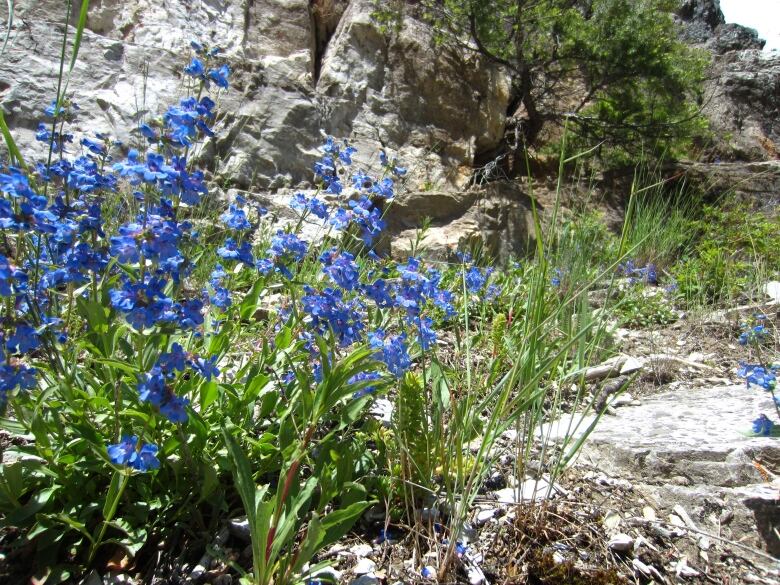#YouShouldGrowThis: Native plants can grow in your garden
CBC gardener Lyndon Penner says growing native plants and wildflowers is possible.
There are plentyof reasons to grow native plants. They offer low maintenance beauty, they often attract local pollinators, and most of them are showy over a long season. Getting to know plants native to your area is a good way to become familiar,and even intimate,with the land where you live. Knowing what existed before that strip mall or new subdivision was built is valuable informationinformation that is rapidly disappearing. Entire ecosystems are being wiped out before we even know what we've lost!
Grow wildflowers athome
Please remember that it is NEVER OKAY to dig up or remove plants from the wild! This frequently results in their death, and it is also a good way to introduce new weeds to your garden. If you find a plant in the wild that you like, the first thing to do is to identify it. Take a photo of it and bring it to a local garden centre, or get yourself a good guide book.
Taking cuttings from native plants is acceptableand often a very good way to get one for your garden LyndonPenner
Once you know what it is, it is easy to find out if it something that is available for sale. If not, perhaps you could propagate it yourself. Taking cuttings from native plants is acceptable and often a very good way to get one for your garden.
I have taken cuttings from native honeysuckles, clematis, ninebark, penstemons, bearberry, and a few others. Be sure to be respectful, and do not take more than you need. You could also gather some of the seeds. Mark the spot where the plant grows and keep an eye on it. Many native plants are easy to germinate, but some are not. Be aware when you gather seeds,you don't know how many years it has been since that plant had enough nutrients to actually produce seeds, and you don't know what small creatures may be relying on those seeds as a food source. Never take more than about 10 per centof the seeds from any given native plant population. If you aren't sure how to germinate them, there are many wildflower and native plant societies, nurseries, and enthusiast groups on the internet who could likely advise you. In many cases, trial and error is often how we learn these things so feel free to experiment with different techniques.

Do your research
Native plants are sometimes slow to establish (many have large root systems) and will not flower well or be showy in the garden until they are a few years old. This is another reason nurseries often don't want to offer them. They are rarely "instant gratification". Some plants behave very differently in cultivation than they do in the wild and can thus be a problem.
Be cautious about plants labeled "wildflowers" or "native plants". The term "wildflower" is often used very liberally by seed companies and nurseries to mean any self sowing annual. It probably isn't anything native to your area and is probably something you don't actually want. The term native plant is often used to mean "native to Canada", but this is a big country and what is native to the east coast may not be native to Alberta or Saskatchewan. An echinacea that is native to Ontario is not the same species that is found in southern Saskatchewan. Do your research, and make good choices! Even within a province, things can vary greatly. Native plants that are ideal for Maple Creek and Estevan may not make great choices for a garden in Nipawin or La Ronge, even though all of those places are in Saskatchewan.

Take a photo, save your back
A few native plants simply do not adapt to gardens at all. Some have very precise relationships with mycorrhizal fungi and thus are unsuitable for gardens. Some come from high altitudes where the conditions would be impossible to recreate in a garden setting. In these instances, these are plants best photographed and enjoyed in the wild. Sometimes, hybrid or garden forms of native plants are better choices than the unrefined species itself. Don't be a purist.Goldenrods (solidago) are lovely native plants that flowerlate in the year and attract butterflies, but in gardens they tend to be floppy and prone to mildew. The hybrid forms of goldenrod (largely developed in Germany) are more compact, flower longer, and have better disease resistance.The prairie crocus (pulsatilla) is fine as a garden plant, but the hybrid forms have much larger flowers, deeper colouring, and are a lot more showy. They also flower significantly longer and produce a larger number of blossoms. These are things to consider.
Did this work for you? Have more questions? Let us know on Twitter @CBCSaskor Facebookand use the hashtags #YouShouldGrowThis and #YouShouldDoThis.












_(720p).jpg)


 OFFICIAL HD MUSIC VIDEO.jpg)
.jpg)



























































































